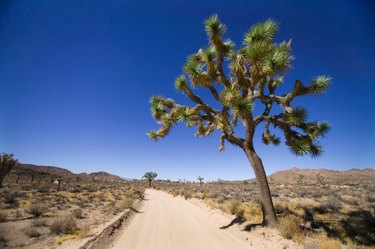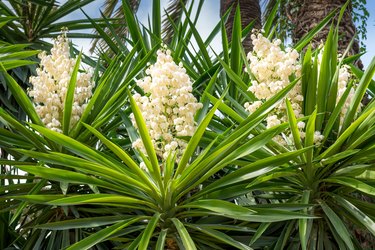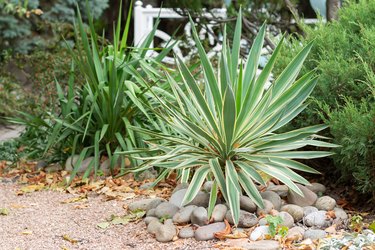
Yuccas (Yucca spp.) are native to the arid landscapes of North and Central America and nearby West Indies, in U.S. Department of Agriculture plant hardiness zones 4 through 10. The various types of yucca plants produce long, pointy leaves and upright flower spikes, which make them attractive additions to gardens with dry soils and abundant sunlight. Think twice about cutting the top off a yucca plant, as it can create a rather ugly plant for a few years.
Tip
In general, you can cut off the top of your yucca plant. It may grow a new stem from buds below the cut or produce offsets from the root system.
Video of the Day
Growth Characteristics of Yucca
About 40 species of yucca exist, according to the University of Arizona Cooperative Extension. Yuccas grow as perennial evergreen shrubs or small trees, depending on how tall of a stem they develop after decades of slow growth. When young, the rosette of leaves emanate from a central pointy growing point or tip. As new leaves emerge and orient horizontally, the oldest and lowermost leaves eventually die and wither away. The constant appearance of new leaves eventually creates a trunk-like stem.
Video of the Day
Very old plants may sprout suckering clone plants from their roots. In general, new growth on a yucca plant only rises from the growing tip. If you cut the top off of the plant, it may or may not produce a new growing tip.

The old leaves on yucca plants turn brown and die from the bottom up. Plant Delights Nursery suggests trimming the dead foliage from the bottom of the plant to reveal the tree-like trunk. Alternately, leave the skirt of dead leaves on the yucca.
Yucca Pruning Concerns
Before you begin, put on long sleeves, long pants, closed-toe shoes, gloves and safety goggles. Sterilize your cutting tools by dipping the blades in Lysol, according to the University of Minnesota Extension.
Pruning off the top growing tip on a yucca effectively halts the plant growth and addition of height. No new leaves emerge from the top of the plant and the leaves present will continue to photosynthesize light but eventually die and drop off. New leaves will occur only if dormant buds under the pruning wound sprout and become the new upright stem leaders. Cutting the top off a yucca also creates a stark, ugly plant that resembles a decapitated body with abrupt architectural silhouette.
Deadheading a Yucca
The most common pruning maintenance conducted on yucca plants is removal of spent flower spikes, a task referred to as deadheading. Once the flower spikes produce any seeded fruits and they drop away, the dried barren stalk persists for several months. To improve the appearance of the yucca, cut off the old flower stalk at the base, as close as possible to its origin near the growing tip. Do not accidentally cut or damage the growing tip, otherwise new leaves may not grow to keep the yucca looking uniform and attractive.
If you aren't sure what kind of plant is growing in your garden, monitor it as it blooms. Yuccas may be easily confused with century plants (Agave spp.), hardy in USDA zones 8 through 10. Yuccas grow slowly and develop a trunk-like stem, whereas century plants lack stems and remain a rosette of leaves. After flowering, however, the yucca lives on while a century plant dries up and dies.
Alternatives to Topping a Yucca

If a yucca plant is getting too tall or lanky in habit, it may be better to completely cut away the tall stem and allow the small plantlets, also called pups, at the base to replace it and create a bushy, more attractive specimen. Cutting off a lone yucca stalk to the ground may not result in new pups, but it usually does on plants with strong root systems in a few months. Food made in the plant leaves fuel the sprouting of plantlets at the base of older yucca plants.